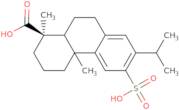
Información del producto
- (1R,4aS,10aR)-1,2,3,4,4a,9,10,10a-Octahydro-1,4a-dimethyl-7-(1-methylethyl)-6-sulfo-1-phenanthrenecarboxylic acid
- 1-Phenanthrenecarboxylic acid, 1,2,3,4,4a,9,10,10a-octahydro-1,4a-dimethyl-7-(1-methylethyl)-6-sulfo-, (1R,4aS,10aR)-
- 1-Phenanthrenecarboxylic acid, 1,2,3,4,4a,9,10,10a-octahydro-1,4a-dimethyl-7-(1-methylethyl)-6-sulfo-, [1R-(1α,4aβ,10aα)]-
- 12-Sulfoabieta-8(14),9(11),12-Trien-18-Oic Acid
- 12-Sulfodehydroabietic acid
- 13-Isopropyl-12-sulfopodocarpa-8,11,13-trien-15-oic acid
- Abietic acid, dehydro-6-sulfo-
- Ecabetum
- Ecabetum [INN-Latin]
- Podocarpa-8,11,13-trien-15-oic acid, 13-isopropyl-12-sulfo-
- Ver más sinónimos
- Unii-2K02669Kwp
Ecabet sodium is a drug that belongs to the class of antimicrobial agents. It is used for the treatment of eye disorders, such as dry eye syndrome and allergic conjunctivitis. Ecabet sodium also has an activity index, which means it can be used for the prevention and treatment of bowel disease caused by Clostridium difficile. Ecabet sodium inhibits bacterial growth by binding to the bacterial membrane potential and causing depolarization. This leads to leakage of potassium ions and eventually cell death due to osmotic imbalance. The monosodium salt is a substrate of toll-like receptor 4 (TLR4), which may be responsible for its anti-inflammatory effects in colitis models. The polymer composition of ecabet sodium is similar to that of glucuronides, which are excreted through the kidney unchanged. Hence ecabet sodium offers a new way to treat patients with bowel disease who have impaired renal function or are on dialysis.br>END>>
Propiedades químicas
Consulta técnica sobre: 3D-IBA15927 Ecabet
Si desea solicitar un presupuesto o realizar un pedido, por favor añada los productos deseados a su carrito y solicite un presupuesto o pedido desde el carrito. Es más rápido, más barato, y podrá beneficiarse de los descuentos y las ventajas disponibles.





